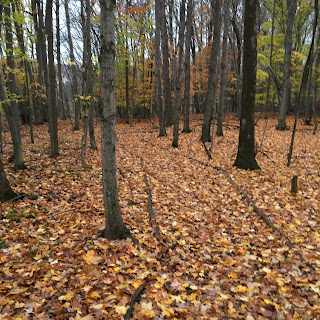Thursday, Remi and I returned to Forest Hill Nature Area for our weekly hike. The early morning weather included thick clouds, spotty light rain and a temperature of 36 degrees with a stiff southwest wind. Descending Energy Hill, I paused next to Mallard Marsh to observe a milkweed in its final stage of life and envisioned what it may have looked like last summer. I moved quickly through Bobolink Meadow and entered North Woods where the deciduous canopy above me was nearly leafless while the ground below revealed a colorful leaf litter of aspen, beech, oak and maple. At the base of a dying ash tree, I spotted a small bracket fungus called a Red-banded Polypore. Exiting the woods, I circled west around Succession field and passed through Birch Row where most of the trees had dropped their leaves on the path below. Soon after entering South Woods, I could easily spot a giant Puffball mushroom (approximately 8 inches in diameter) lying on the leaf litter. I continued along the edge of Swanson Swamp where the brilliant red fruit of winterberry caught my eye. These berries are toxic because they contain an alkaloid called Theobromine that is almost identical to the caffeine found in coffee and tea. Large quantities of this toxin can cause symptoms similar to a "caffeine overdose," such as dizziness, nausea, diarrhea, stomach pain, an elevated pulse or drowsiness. Leaving the woods, I headed east past Willow Wallow and ascended Reflection Hill where I paused to gaze down at a bird-less Grebe Pond. I headed south down the hill and circled east and north into Native Grassland where I stopped to pick one of many seed heads of Wild Bergamot and enjoy its fragrance. These seed heads last throughout the winter looking like coat buttons on the head of a knitting needle, and strewing seeds as they wave in the wind. This wildflower was so named for the similarity of its fragrance to the Bergamot orange, a small orange-lemon fruit grown near Bergamo, Italy, used in perfume making. Heading north, I paused to look again at Grebe Pond whose surface is once again free of the thick, green covering of the invasive weed, Water meal. Finally, we passed the barn and made it to the car
for our trip home.
Summer memories, meadow scene
Teardrop pods, spiny and green
Balls of blossoms, fragrant and pink
Bees and butterflies ready to drink
Oblong leaves, oozing with white
Feeding caterpillars, welcome sight
Autumn is here, weather befit
Leaves have dropped, pods split
Go with the wind, silky seeds
Such is life of nature’s Milkweeds
D.
DeGraaf



